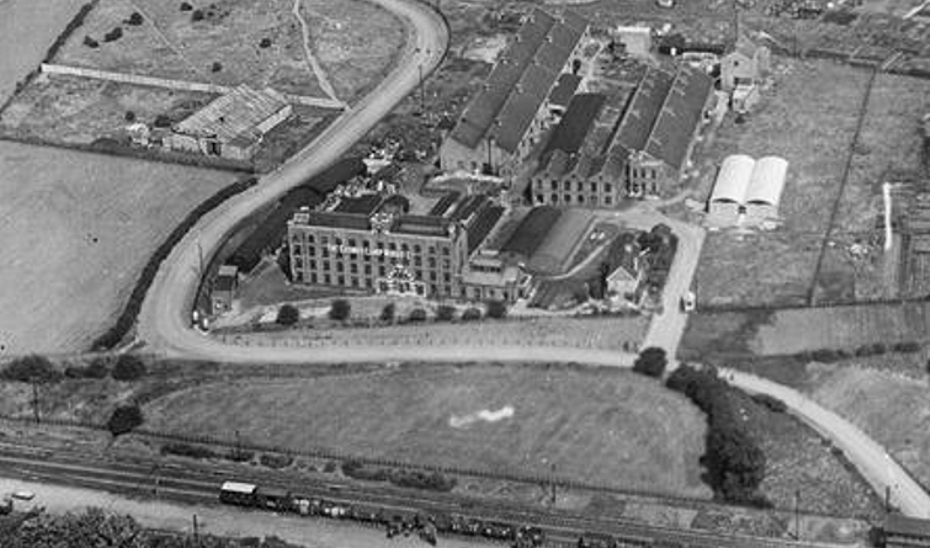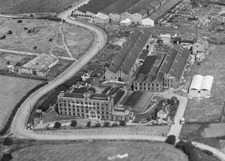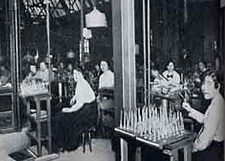|
|
|
Introduction
The lampworks in Brimsdown was established by the German firm Julius Pintsch, just a few hundred metres away from the Ediswan Ponders End works. Following the outset of WW1 it was transferred to British ownership before ultimately being taken over by British Westinghouse, Metropolitan Vickers, Associated Electrical Indusries, Edison-Swan, and finally Thorn EMI. Its precise date of closure is not known, but it is certain that lampmaking was stopped fairly quickly and the site was completely taken over for valve production.
|
 Cosmos Lamp Works, 1922
Cosmos Lamp Works, 1922
|
| Address |
Millmarsh Lane / Green Street |
| Location |
51.6570°N, -0.0290°E |
| Opened |
1909 |
| Closed |
Lampmaking stopped shortly after 1928. Valve production possibly continued until at least 1971. |
| Products |
Incandescent tungsten lamps, electronic valves |
Foundation under Pintsch
The German company founded by Julius Pintsch was a pioneer in the field of oil and gas lighting, and quickly acquired a strong position after developing a vibration-resistant gas lighting system suitable for use on the railways. Subsequently in 1886 when Carl Auer von Welsbach developed the incandescent gas mantle, it was with Pintsch gas lighting systems that they were first marketed and from this time onwards the companies became closely associated. 1893 saw the company diversify again into the manufacture of carbon filament electric lamps, which were first produced at the vast Pintsch works in Fürstenwalde, Germany. Auer also established its own incandescent lamp company following the invention of the metal filament lamp, and ultimately the electric lamp operations of Auer and Pintsch together with AEG, Siemens and Bergmann were merged to form the present Osram company.
Meanwhile when the German Patent laws were introduced, Pintsch feared that their British patents would be withdrawn and decided to establish manufacturing in the UK. In 1909 Pintsch purchased "The Power Plant Construction Company" in Brimsdown, and established on that site "The Imperial Lamp Works Ltd." One year later in order to make the company appear more British, it was re-named "Brimsdown Lamp Works". As hostilities began to further intensify between the two countries, Pintsch feared that the overseas assets would soon be seized. He therefore decided to transfer 70% of the capital in the British factory for safekeeping to the managing director of that site - however this was not sufficient, and when war broke out the company was promptly confiscated by the British Government.
For the next two years times were intensely difficult for the Brimsdown Lamp Works. Its supply of raw materials was largely cut off, and lampmaking machinery had to be sold off to competitors in order to pay the wages of the staff.
|
Cosmos Lampworks
The Public Custodian of Enemy Property eventually found a buyer for the factory, and on 23rd July 1917 it was taken over by British Westinghouse, which at the time was a wholly owned subsidiary of the American parent company of similar name. Westinghouse was of course tremendously powerful in the American lamps market, but had not exploited its overseas lighting business to the same extent as its competitors. It had established a vast manufacturing site at Trafford Park in Manchester for the manufacture of heavy electrical machinery, but lamps were only sold from 1906 when the Westinghouse Metal Filament Lamp Co. was formed to begin sourcing a supply from the Westinghouse incandescent lamp works in Atzgersdorf, Austria. The lack of a British lamp manufacturing operation was a considerable weakness, because lamps were proving to be an immensely profitable business in comparison with the heavy electrical industry.
In order to improve the supply situation, British Westinghouse purchased the Atzgersdorf factory from the American parent in 1913 - perhaps a foolish move in view of the fact that war broke out the following year, and the supply of lamps was once again interrupted. It was therefore a particularly valuable opportunity for British Westinghouse to be able to purchase the Brimsdown works when it became available for sale.
In an attempt to relaunch the ailing company, it was re-named "Cosmos Lamp Works". Around this time the entire British Westinghouse company was also suffering, largely because of its very public foreign ownership and the immensely strong preference of customers at the time to purchase goods that were manufactured locally by British companies. Similarly it was proving very difficult for this major electrical engineering company to secure government contracts, which were funding much of the industry during the period when the country was being widely electrified. When in 1916 it was refused admission to Federation of British Industries because it was American-controlled, the board began to seriously consider the value of its American ownership and a new holding company was formed, with the intention to build up sufficient capital to purchase the shares from the American parent.
It is worth noting that one of the co-founders of of the Federation of British Industries was Dudley Docker, owner of the train-building Metropolitan Carriage, Wagon & Finance company, and a staunch promoter of British manufacturing. On several occasions he played a pivotal role in the development of the British electrical industry, and following his denial of British Westinghouse to enter the federation, he offered to provide the financial assistance that British Westinghouse was seeking to buy its independence from America. The rest of the cash was put up by Vickers Ltd, a major British shipbuilding and industrial engineering company.
By the end of 1917 the deal had been completed, and the company was re-named the British Westinghouse Electrical and Manufacturing Company, of which the Cosmos Lampworks was a wholly owned subsidiary. A few years later, perhaps in preparation for much grander plans which ultimately led to the amalgamation of practically all of the British heavy electrical industries, Docker attempted to sell off his shareholding. He tried to persuade the board of British Westinghouse to amalgamate with Vickers, but failed. He then tried again to structure a merger with The General Electric Company of London, which aslo failed. Eventually however, Docker agreed terms with Vickers that it would purchase not only his shares in British Westinghouse, but also all of the shares in his own company, The Metropolitan Carriage, Wagon and Finance Company, for almost thirteen million pounds. On September 8th 1919 the newly amalgamated corporation was re-named "The Metropolitan-Vickers Electrical Company", commonly known as Metrovick, which continued to operate the Cosmos Lamp Works under that name as its rather profitable lampmaking subsidiary for a number of years.
Although Docker might then have been publically and financially out of the picture, his involvement in the future fortunes of the new enterprise were far from over and in such a way that they would appear to conflict strongly with his previously strong feelings about British manufacturing. Over the following years he liased with Gerard Swope, the influential President of GE of America, to covertly purchase shares in Metrovick under his own name but in fact on behalf of GE. Apparently even the board of Metrovick had no idea that the ownership of their company was progressively slipping into the hands of GE, until majority status had been reached and it was too late to take any actions.
In parallel GE had been playing a similar trick to covertly take over the General Electric Company of London, but that company's shareholder, Hugo Hirst, astutely noticed the large quantities of shares in his company that were changing hands and being aware of Swope's desires for an amalgamation of the entire British electrical industry, took actions to deny foreign shareholders of the right to vote on the board. The mysteriously purchased shares were swiftly put up for sale following his actions! GE of course also owned another major British industry, the British Thomson-Houston Company along with that company's own important shareholdings in other major electrical industries such as Edison-Swan Electric. Once it had taken financial control of Metrovick a full merger of these giant corporations was then on the cards. In 1928 GE wasted no time in forming the new holding company Associated Electrical Industries, AEI, into which BTH, Metrovick, Ediswan, and all of the other subsidiary electrical companies were transferred.
Following the discovery of the British Government that a major portion of the country's electrical industry had fallen into foreign ownership and the establishment of the Anti-Trust laws in the following years, GE was compulsorily required by the Governor of the Bank of England to dilute its shareholding in AEI to much smaller proportions. In view of Docker's close links with both politics and industry, and his formerly strong views that not only should British industry be controlled by British owners but that it would also be beneficial for the numerous smaller competing electrical industries to be amalgamated into a single great corporation, one cannot help but wonder if his mysterious agreement to arrange for his companies to fall into American hands was all part of a much grander plan to simply use the Americans to carry out the necessary amalgamation, and then endeavour to see the shareholding forcibly returned once again to local investors.
|
End of Lampmaking
During the 1920s the Cosmos Lamp works had made the same evolution as so many other lamp factories of diversifying its production to include radio valves. At the time of the takeover by AEI, significant rationalisation of manufacturing took place. On the electronics side it was decided that the entire radio valve and cathode ray tube production of the group would be transferred under the control of Edison-Swan, while BTH Mazda would focus on large valves for industrial applications. On the lamps side it was decided that Metrovick should stop incandescent lamp manufacturing of its own, but would continue as a selling company having lamps made under its brand name by the BTH-Mazda and Siemens-Ediswan subsidiaries of AEI.
Presumably before 1930, lampmaking had therefore come to an end at Brimsdown and the factory is believed to have been rationalised to concetrate on the manufacturing of radio valves. This would have been a logical decision since it was located only a few hundred metres away from the vast Ediswan works at Ponders End. It is not known precisely when the valve production came to an end, but following the takeover of the AEI Lamp, Valve, Cathode Ray Tube and domestic appliance operations by Thorn EMI, it is cited that the Thorn Valves and Cathode Ray Tubes division was still manufacturing at Brimsdown. In view of the proximity of the Brimsdown and Ponders End factories though, it is possible that there is some confusion here and that Brimsdown had in fact been closed entirely following the AEI takeover - or equally indeed that the Ponders End site was becoming increasingly cramped, and the valve and CRT manufacturing of Ponders End shifted to the Brimsdown factory. In the mean time the Ediswan site had sprawled outwards towards Brimsdown and the entire space between the two original sites had been filled by electrical manufacturing industries, so it is often difficult to draw a boundary between which products were made at which factory at a given time.
|
Photographs
|
 |
|
 |
|
 |
|
 |
|
| Factory Entrance |
|
Aerial View, 1922 |
|
Aerial View, 1922 |
|
Vacuum Lamp Stem Department |
|
| 1 |
Deutsche Direktinvestitionen in Großbritannien 1871-1918, pp.123-124. |
| 2 |
Metropolitan-Vickers Electrical Company 1899-1949, J. Dummelow, 1949. |
| 3 |
Grace's Guide entry for Cosmos Lampworks. |
| 3 |
Grace's Guide entry for British Westinghouse. |
| 5 |
Wikipedia Deutschland - Richard Pintsch. |
| 6 |
Siemens Brothers 1858-1958, J.D. Scott, Weidenfeld & Nicholson 1958, pp. 140-142. |
| 7 |
Death of a Lightbulb, J. Otten, Blue Ocean Publishing 2012, pp.62,72,136,272-273. |
| 8 |
Anatomy of a Merger : A History of GEC, AEI and English Electric, R.Jones & O.Marriott, Pan Books Ltd, 1970. |
| 9 |
Britain from Above, Aerial Views. |
|
|
|
|
|